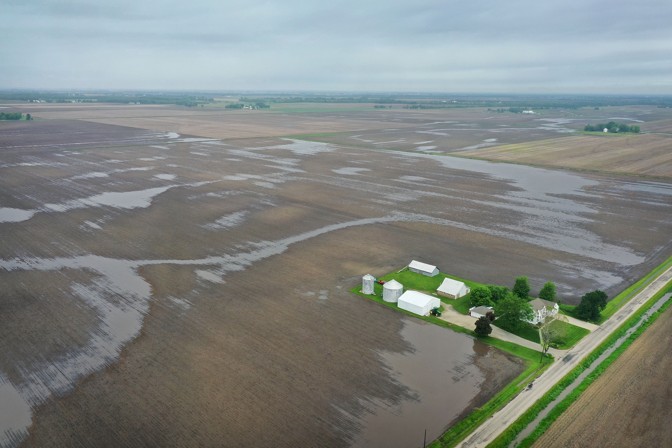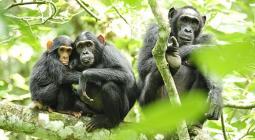These were the “really complex political issues” at the center of the IPCC talks. “Land can’t, at the same time, feed people, and grow trees to be burned for bioenergy, and store carbon,” Stabinsky said. “That conflict of what’s going to take priority as we face greater and greater climate challenges” defined the talks, she said. “There’s going to be more and more desire to try to use land to pull carbon out of the atmosphere, and that’s going to interfere with food production.”
This Land Is the Only Land There Is.

Here are seven ways of understanding the IPCC’s newest climate warning.
1. There is no shortage of scary facts in the major new report on climate change and land, a summary of which was released today by a United Nations–led scientific panel. Chief among them: For everyone who lives on land, the planet’s dangerously warmed future is already here. Earth’s land has already warmed more than 1.5 degrees Celsius (2.6 degrees Fahrenheit) since the industrial revolution, according to the Intergovernmental Panel on Climate Change. That’s the same amount of warming that climate activists are hoping to prevent on a global scale.
This spike makes sense, scientifically: Land warms twice as fast as the planet overall. Earth as a whole has warmed by only 0.87 degrees Celsius (1.5 degrees Fahrenheit) during the same period. But this increase makes the stakes of climate change clear: When scientists discuss preventing “1.5 degrees Celsius of global warming,” they are really talking about forestalling 3 degrees Celsius—or 5.1 degrees Fahrenheit—of higher land temperatures.
And land temperatures are what humanity usually cares about. Land, really, is what humanity cares about. That’s the point.
2. If the report has an overarching theme, it’s that land is extremely scarce, we need it for everything, and we are already using most of it. More than 70 percent of the planet’s ice-free land is already shaped by human activity, the report says. As trees are felled and farms take their place, this human-managed land emits about a quarter of global greenhouse-gas pollution every year, including 13 percent of carbon dioxide and 44 percent of the super-warming but short-lived pollutant methane.
But unlike other sources of pollution—such as the burning of fossil fuels, which must be quickly reduced globally—land can’t just be shut down. It must be made into a tool in the climate fight. The report’s more than 100 authors, hailing from 51 countries, say that this will require immediate action from farmers, bankers, conservationists, and policy makers worldwide. And to reallysucceed, it will require hundreds of millions of affluent people in the Northern Hemisphere to change their diet, eating many more plants and much less meat—and especially much less red meat—than they do now.
These changes must happen fast, because land problems have a pesky way of metastasizing. Louis Verchot, a scientist at the International Center for Tropical Agriculture and an author of the new report, described the cascading consequences of warmer air temperatures at a press conference this week.
“As the biosphere gets warmer, we increase evaporation,” he said. “And as we increase evaporation, ecosystems dry out and burn when they normally wouldn’t do that. And when soils get dry due to increased evaporation, we get longer heat waves.” And longer heat waves, of course, make the biosphere warmer still, starting the cycle again.
Around much of the world, this cascade has already begun. Heat waves worldwide have gotten longer, hotter, and more common, according to the IPCC. Deserts are expanding toward the poles, while zones of colder weather are shrinking. Dust storms are kicking up more often. And evidence suggests that every year from 1961 to 2013, an additional 1 percent of the world’s drylands slipped into drought.
As I said, there are a lot of scary facts here.
3. Yet one fact—maybe the most important idea in the report—didn’t frighten me so much as leave me awestruck. It comes early in the document: “People currently use one quarter to one third of land’s potential net primary production for food, feed, fiber, timber and energy.”
It’s a lot of jargon. But here’s what it means. Recall from high-school biology that primary production is the conversion of sunlight into chemical energy via photosynthesis. Besides the tiny creatures that live in deep-sea heat vents and other extreme environments, all life on Earth derives its energy from the sun. You and I don’t get our energy directly from photosynthesis, but we eat plants—or things that ate plants—that do. Every major food chain on Earth begins with a plant, somewhere, humbly transfiguring photons into sugar.
This is the net primary production that the IPCC alludes to. It’s saying that the human demand for food, meat, clothes, and warmth now consumes at least 25 percent of the net product of photosynthesis on land. The free-wheeling, far-reaching maw of our material metabolism—that thing we normally call the global economy—devours as many as one out of every three sugar moleculesmade by dirt-bound plants, on net. Plants are one of the few things in the universe that can work this magic, as far as we know. And we have roughly hooked one out of every four of them into our planetary system of consumption and speculative exchange.
This isn’t scary, necessarily, but it is strange. Whatever that kind of arrangement is, it doesn’t seem constrained by economics or agriculture or ecology. And this is the most daunting aspect of the new report. For the scientific community, this document is a milestone because it assumes that land is scarce and precious. Climate researchers, for decades, have sometimes talked about land as if it is a limitless global sponge capable of cleaning the worst mess in human history. A recent high-profile study, for instance,cheerfully suggested soaking up most of the planet’s carbon pollution by planting 1.2 trillion trees across 2.2 billion acres worldwide. It was impressive research, but it was immediately sold to the public as The Solution to Climate Change. And there’s a problem with that. Those 2.2 billion acres—an area roughly the size of the continental United States—are already in use. They comprise, in large part, the planet’s most productive farmland! And in the decades to come, that farmland is going to be very useful if we hope to feed the 9.8 billion people who will soon reside on the planet.
4. In some ways, this is the most unavoidably political document that the IPCC has ever published. Its report last year, on the dangers of global warming beyond 1.5 degrees Celsius, called for an unprecedented transformation in the globe’s energy system. It demanded a rapid switch to carbon-free energy systems. But talking about the energy system is, in this context, relatively easy. No one’s ever gone to war over electric cars or renewable portfolio standards. But land is different. It is home, and the possibility of home. The relationship between people and land is the most treasured and unresolved idea in global politics. As the IPCC says, land “provides the principal basis for human livelihoods and well-being, including the supply of food, freshwater and multiple other ecosystem services, as well as biodiversity.” Another authorityput it like this: “Cursed is the ground for thy sake … By the sweat of your face you shall eat bread, till you return to the ground, for out of it you were taken.” Chemically speaking, of course, we are mostly water. But everything we love about ourselves is solid, and therefore made of land.
Accordingly, everyone has opinions about it. Somewhat notoriously in climate circles, the final summary of every IPCC report is written by the world’s worst committee process. Over a marathon five days, the lead scientific authors sit at the front of a room and painstakingly read every line of the document to every national delegation that cares to attend. At any time, any delegation can more or less raise any issue with any word, and before the report can be published, every country’s delegation must acquiesce to it in full. Historically, oil-producing countries such as Saudi Arabia use this process to raise one concern after another, bogging down the proceedings and effectively excising the strongest language from the final document.
But the process this time, which took place in Geneva, unfolded differently. The world’s developing countries might normally raise a few issues with the IPCC’s initial proposed language. For this report, they asked for changes to line after line, according to Doreen Stabinsky, an environmental-politics professor at the College of the Atlantic who observed the talks.
“A lot of countries want to make sure that they see themselves, and their specific interests and issues, in every single paragraph,” she told me this week. “Land is something that’s so local. People come with the land and food-security issues in their country. You can tell people in the room care really deeply about these questions, but it has made things incredibly slow. There’s also some really complex political issues at the center.”
The biggest of these issues: Land can’t really multitask.

5. Nearly every American knows what our peculiar national grid of farm and field looks like. During a drive across the Midwest, it rolls past, flipbook-like: field-field-road, field-field-road. During a coast-to-coast flight, it unfurls outside the plane window like a vast Cartesian quilt, lines meeting lines at right angles, circles of irrigation locked within squares. This grid system, formally known as the Public Land Survey System, covers much of the land outside the 13 original colonies.
What every American may not realize is that this grid gives us a great advantage when thinking about area. Each of those grid squares is about one square mile. The Earth’s total land surface is about 52 million square miles. So we only get 52 million grid squares to work with as a species. While 52 million squares may seem like quite a lot, consider that each of them is worth incommensurately more than $1. At some point in the past, $52 million might have seemed like quite a lot of money. But now it cannot buy a 10-foot sculpture of an orange balloon dog.
These 52 million grid squares cannot only service our needs. They are all the land, period. They must also hold the vast, lovely, unknowable thing that we call nature—every shady spot, every mountain stream, every sand dune. (The IPCC authors call this, somewhat dryly, “biodiversity and ecosystem services.”) Every grain of rice and cobalt mine, every sidewalk square and platypus, has to be somewhere on that 52 million.
8 August 2019
The Atlantic







